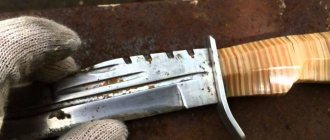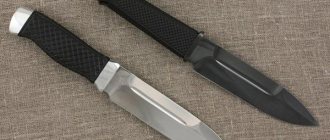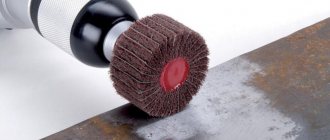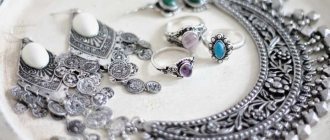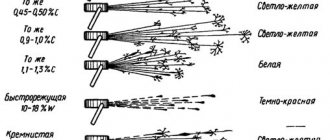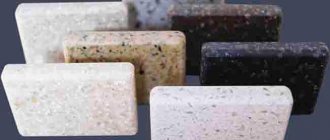Cupronickel is an alloy based on nickel and copper that looks like silver. It is believed to have been invented in China before the Common Era and was used to mint coins and create jewelry. Most of us are familiar with it from cutlery - cupronickel spoons and forks look noble and solid, and they can be especially often found in the kitchens of older people.
Cupronickel silver cutlery looks like silverware; they also quickly oxidize and darken
Cupronickel silver is similar to silver not only in appearance, but also in its tendency to oxidize. Over time, especially in a humid environment, products made from this alloy become covered with brown spots, which then turn black. Oxidation is the “merit” of copper, which is part of cupronickel.
How to clean nickel silver spoons and forks to restore their shine and attractive appearance? To do this quickly and efficiently, you need to know a few secrets, which we will tell you about in our article.
To find out whether your spoons are made of silver or cupronickel, you need to show them to a master in a jewelry workshop
Cause of darkening
Cupronickel is an alloy of metals, one of which is copper. It quickly oxidizes when exposed to moisture. An unaesthetic coating appears on appliances or jewelry. To avoid this trouble, you need to follow the recommendations for caring for cupronickel products:
- do not use chlorine-containing products for washing;
- clean off food residues;
- wipe dry after cleaning;
- store away from moisture.
Cupronickel silver products cannot be washed in the dishwasher. After such cleaning they will darken. It is better to clean with your hands in warm water with the addition of shavings from laundry soap.
Why do cupronickel spoons darken?
In order for cupronickel tableware to please its owners for a long time and always look as if it had just been purchased, you need to know some of the features of caring for copper-nickel alloy.
Causes of darkening:
- Humidity causes small brown spots to appear on the top layer of devices. After washing, it is necessary to wipe the nickel silver dry with a dry cloth and store it in a closed cabinet, away from moisture.
- Insufficiently thorough washing of dishes from food residues. Tiny particles can remain in scratched areas and leave unsightly dark marks on appliances.
- When in contact with chlorine, detergents, abrasive substances, and household cleaning powders, copper, one of the components of the alloy, begins to oxidize and turn black. Moreover, it is not necessary from direct contact with the product; sometimes the smell of chlorine is enough for table nickel silver to begin to become covered with brown spots.
- Alloy items may darken due to dishwasher use.
- Cupronickel objects often turn black when in contact with devices made from other materials. To slow down the oxidation reaction, items should be stored separately from other items.
Modern means
If the products have darkened, they can be quickly refreshed. For this purpose, special care products for cupronickel items are produced. They come in the form of liquid, gel or wipes soaked in a special solution. It is enough to follow the instructions indicated by the manufacturer on the packaging. Some of the substances can protect objects from moisture by covering them with a thin protective layer.
Regular kitchen powders and creams are also suitable for cleaning. But they should not contain aggressive components.
Decoctions for cleansing
You can also prepare special cleansing infusions. This is another wonderful folk remedy that will help you cope with even the most severe stains.
Suitable for preparing the decoction:
- Garlic peel;
- Potato.
Potato broth is considered less effective, but the most gentle. It does not harm the surface of products, so you can safely use it for items with gold or silver inserts.
A decoction of garlic peels is prepared as simply as possible. The husk needs to be boiled, and the more of it, the better the broth will cope with darkened spots.
Thus, you can restore the former sparkling appearance of cupronickel accessories in different ways, without spending money on additional cleaning products. The main thing is to take care of such items in a timely manner , to prevent water from getting into the places where they are stored, then they will always be in excellent condition.
Home Recipes
If there is no special remedy or there is no desire to use “harmful chemicals,” you can use folk remedies.
- Baking soda. It needs to be moistened to a paste. Apply to a soft cloth and clean the products from darkening.
- Ethanol. It can be replaced with vodka without dyes and flavors. It is enough to moisten the sponge in alcohol and wipe the dark places.
- Ammonia. You need to pour it over the items for about 20 minutes. Then rinse well under running water.
- Vinegar. With equal effectiveness against blackness, you can use natural apple or 9% essence. One teaspoon of the substance is poured into a glass of water. Cupronickel silver spoons and forks are treated with the resulting solution.
- Laundry soap. Apply to a soft toothbrush and brush “problem” areas.
- Raw chicken egg white. They moisten a napkin with it and wipe the cupronickel. The product is soft, so it is suitable for gold-plated products. It will clean stains without damaging the finish.
Regardless of the chosen cleaning method, nickel silver products must be rinsed with clean water before and after the procedure. And then wipe dry.
What is cupronickel, its pros and cons
Cupronickel is an alloy based on three components: nickel, copper and zinc. Sometimes it also includes some other components, for example, manganese or iron. Cupronickel can be distinguished by its characteristic appearance, reminiscent of silver. It owes this feature to its second popular name - “silver of the poor.”
Just in case! We wrote about how and how to clean silver in this article.
Products made from this material have many advantages:
- Low cost;
- Presentable appearance;
- Strength;
- Long service life;
- Rust resistance;
- Low thermal conductivity.
But there are two big disadvantages:
- Regular care;
- Rapid loss of shine and appearance of blackness.
Now, let's look at how to clean nickel silver so that it regains its former shine.
Removing old stains
When you need to clean an old set or the contamination turns out to be too persistent, you can resort to more complex procedures. Cleaning will take time, but the result will be more noticeable.
Eggshell
- Chop the shells of four chicken eggs and pour into a saucepan.
- Pour 2 liters of water and put on fire
- After boiling, add a tablespoon of salt.
- Dip nickel silver products into the solution.
- Boil over low heat until the desired result is obtained (about ten minutes).
Aluminium foil
- Cover the bottom of a frying pan or saucepan with foil.
- Add two tablespoons each of baking soda and salt.
- Pour a liter of boiling water and put on fire.
- After the foam has subsided, put in cupronickel products.
- After ten minutes, the foil will begin to turn black, and the products, on the contrary, will become light.
You can also use foil to refresh gold and silver items. But the method is not suitable for cleaning thin coatings of these metals. One procedure is enough to process jewelry or small cutlery. Antique coins or cups with complex designs will need to be processed several times.
Potato or pasta broth
- Boil two or three potatoes or a handful of vermicelli in 1 liter of water in the standard way.
- Remove the ingredients and place cupronickel in the broth.
- Leave for several hours with the lid closed.
- When the broth darkens, the products will be clean.
To clean, nickel silver items can be placed in carbonated drinks such as Coca-Cola for several hours.
Chalk polishing
The most common chalk can be used to polish cutlery items to a shine and remove minor dirt from them.
Polishing procedure:
- Grind the chalk into powder;
- Add a little water until you get a viscous slurry;
- We take a soft cloth (without lint) and apply the mixture on it, with which we polish the products.
If you don’t have chalk, then a non-abrasive toothpaste with silicon oxide in its composition is great for these purposes. It is applied to a damp cotton pad and can be used to clean nickel silver spoons, forks and knives.
Adding shine
When all stains and plaque have been eliminated, you can return the shine to the products. Polishing will help give nickel silver shine. You need to take a flannel cloth or other soft napkin. Apply polishing paste to it and treat the surface. You can buy ready-made paste or make it yourself from the following ingredients.
- Chalk and soap. Chalk powder and soap shavings are combined in a 1:1 ratio. Dilute with water to form a paste.
- Chalk and ammonia. One part of chalk and two parts of ammonia solution are mixed to a homogeneous paste. If necessary, dilute with water.
- Toothpaste and powder. They can be used either separately or mixed.
After polishing, cupronickel is washed under running water and wiped dry.
Egg white
An excellent product for cleaning gold-plated nickel silver is egg white. This natural substance gently cleanses without damaging the protective layer. Cupronickel is cleaned as follows:
- Separate the egg white from the yolk.
- Beat the whites with a whisk or fork until smooth. Don't overdo it; no protein foam is needed.
- Soak a piece of cotton or flannel fabric in the protein mixture and rub the product.
- After removing dark stains, rinse the cupronickel dishes and wipe dry.
Wine vinegar or turpentine is also used to clean gold-plated items. The principle of cleansing is the same as with egg white.
What kitchen utensils are made from cupronickel
Cupronickel is a budget alternative to silver. The alloy was created at the beginning of the 19th century by the French Maillot and Chorier. Over time, its composition was improved, the percentage of metals contained in it changed. In the modern version:
- 30% nickel;
- 1% iron;
- 1% manganese.
This material is resistant to oxidation, corrosion and deformation. But over time, darkening, characteristic of rapidly oxidizing brass and copper, appears on the products.
The range of kitchen utensils made of cupronickel is varied:
- spoons;
- forks;
- knives;
- ladles;
- Turks;
- skimmers;
- caviar;
- shoulder blades;
- cup holders, etc.
Cupronickel silver table sets are often made in the classic Old Russian style.
Cleaning gold-plated cutlery
Gold-plated cupronickel cutlery and cup holders require especially careful handling and regular maintenance. Before the procedure, you need to wipe off dust and degrease them with a napkin soaked in turpentine or vodka, then proceed directly to cleansing in various ways:
- Wine alcohol can effectively clean dark spots and return nickel silver to its radiant shine. Serves for preventive care of gold-plated devices. Use a soft cloth soaked in wine alcohol to thoroughly wipe the darkened objects. Then polish them with a suede flap.
- Beer bath - fill spoons with any type of beer and leave for half an hour - an hour. This product can clean even old stains in complex engraving curves without damaging the gilding layer. Suitable for regular care.
- Fresh egg white - wet a soft cloth and rub the gilded cupronickel. For difficult stains, it is recommended to add one teaspoon of “Whiteness” to the product.
- Soap solution - dissolve one teaspoon of dish soap or shampoo in water and place the utensils in it. After half an hour - an hour, you can carefully clean them with a brush or sponge.
- Add 5-7 drops of ammonia to the soap composition prepared according to the previous recipe. Place the dishes there and leave for 20 minutes. It is important not to leave the items for a long time, otherwise the gold plating may peel off.
- Vinegar - two tbsp. add spoons to water, soak the products in it for 15 - 20 minutes.
- Two tbsp. Pour tablespoons of vinegar into one glass of water, and rub the utensils with a napkin soaked in the infusion. Then rinse well with cold water and wipe dry.
Other recommendations
In most cases, the methods work, but if failure occurs, do not despair - you need to try another method. It is especially difficult to remove oxides that are already several years old. To avoid such difficulties, you need to use the following tips:
- “Major” cleaning of devices is carried out at least once a month;
- in order to refresh the metal, use potato starch (1 tsp per liter of water);
- after cleaning, rub the dishes until glossy;
- cleaned instruments must be well dried;
- To clean nickel silver, do not use abrasive sponges, coarse bristles or chlorine-containing powders. All these products cause severe damage to the metal surface.
Cleaned forks and spoons delight the eye with a dazzling shine and are pleasant to use in everyday life. Even a festive table can be served with such devices; guests will definitely notice the beauty.
